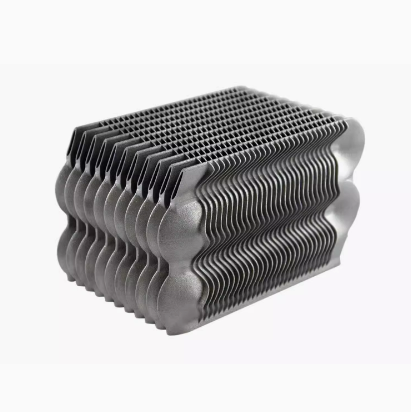NEWS
Benefits of Metal 3D Printing
3D printing has changed the landscape of manufacturing. 3D printing is a more flexible process than other manufacturing methods - allowing manufacturers to go from design to complex metal parts faster, easier and more cost-effectively.
When implemented correctly, metal 3D printing can dramatically improve business efficiency and agility – whether by eliminating the need for design drawings and machine tooling, or drastically shortening the lead time of the product development process.
This article outlines the specific business benefits and technical advantages that companies can gain by successfully implementing metal 3D printing technology.

Business Advantages of Metal 3D Printing
As an emerging technology, many of the tangible business benefits of metal 3D printing are obscured by the hype surrounding the technology. As the technology matures and metal 3D printing applications diversify, its value to the business bottom line manifests itself in three clear ways:
Get products to market faster
By shortening product development cycles using a simple 3D metal printing process, companies can generate more revenue.
Iteration is the most important part of product development—the more iterations, the better the product, but too many iterations can lead to missed deadlines and lost revenue. While there is a lot of work to do in each iteration, most of the time is spent waiting. Waiting reduces the number of iterations you can do and the risks you can take.
Metal additive manufacturing aims to accelerate product development. Using metal 3D printers, companies can quickly and affordably prototype functional parts. Once a design is locked in, the technology can help produce tools, jigs and other parts to produce parts faster. In some cases, they can print small batches of end-use parts, eliminating manufacturing start-up time entirely.
Reduce manufacturing costs
Manufacturing is expensive; it requires skilled labor, advanced machinery and custom tooling, all of which need to work together to produce parts efficiently. Optimized production lines are efficient but often inflexible. In other cases, machines fail to produce molds and other non-revenue-generating parts, and skilled workers often solve problems instead of making new parts.
Metal 3D printing increases manufacturing flexibility and allows more time to be spent producing revenue-generating parts. Whether producing tools and fixtures, reducing unplanned downtime or automating simple tasks, these machines can help organizations leverage resources to produce parts more economically.
Replace inefficient manufacturing workflows
Inefficient manufacturing workflows such as complex procurement processes, unplanned downtime, third-party manufacturers and extended manufacturing queues can impact the entire enterprise, and simple logistical issues can wreak havoc.
3D printed metal parts will help businesses become more dynamic and responsive. Using metal 3D printers enables organizations to compress product timelines and reduce labor, time and money between CAD design and functional parts. Markforged’s 3D metal printing process is designed to increase part flexibility, so parts can be digitally stored, updated, and then printed on demand in a seamless, intuitive workflow.
Technical advantages of metal 3D printing
The technical advantages of using 3D metal printing extend far beyond the ability to create ultra-complex parts. They arise from manufacturing challenges that metal 3D printing is better suited to solving than traditional manufacturing methods. Companies that successfully adopt additive manufacturing apply its unique strengths to the challenges they face.
Ability to design geometrically complex parts
Why do companies allow designs to be limited by traditional manufacturing constraints?
In addition, in metal 3D printing, parts of complexity are very cheap to manufacture. Unlike traditional manufacturing, additive manufacturing is cost-independent of part complexity. It is better at bends, natural shapes and complex geometries than subtractive CNC machines. Therefore, complex parts can be produced cheaper, easier and faster using metal 3D printers.
Metal 3D printers are particularly suitable for manufacturing complex parts
From ultra-complexity to process optimization, they can print everything from generative design structures to custom cooling channels. For these parts, 3D printed metal strength performs well in demanding applications.
In addition, 3D printers can create parts with complex curves, shapes or cavities where material cannot be removed by traditional subtractive manufacturing processes.
The cost of printing complex parts is much lower than the cost of machining.
The ability to make parts without tools
Many traditionally manufactured parts require custom tooling and fixtures. These parts, while critical to the manufacturing process, consume manufacturing bandwidth without generating revenue. Particularly for parts produced in low volumes, tooling costs can make manufacturing prohibitively expensive.
No matter what part is being printed, no custom tooling or fixture setup is required to run a metal 3D printer. This reduces the overhead costs associated with manufacturing and produces low-volume parts more quickly and cost-effectively.
The ability to produce parts without drawings or CAM
Machined parts require drawings, CAM, or both—3D printed metal parts do not. Metal 3D printing software automatically generates and executes the paths needed to build the part. Instead of generating drawings and programming CAM, all manufacturers have to do is position the part and select materials and basic print settings.
In addition to automatically generating paths, most metal 3D printers require little supervision when manufacturing parts. Manufacturers can go from design to parts with shorter lead times and less labor.
RELATED NEWS
- What does CNC mean? 2023-08-14
- Sheet Metal Fabrication Technology And Applications 2024-01-14
CATEGORIES
CONTACT US
Contact: Artcoway
Phone: +86 13827407122
E-mail: sally@artcowaymodel.com
Add: Baoan District, Shenzhen, Guangdong, China
 Artcoway
Artcoway